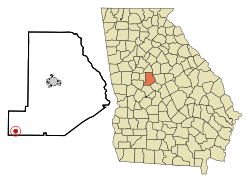Type a search term to find related articles by LIMS subject matter experts gathered from the most trusted and dynamic collaboration tools in the laboratory informatics industry.
Culloden, Georgia | |
|---|---|
 Location in Monroe County and the state of Georgia | |
| Coordinates: 32°51′47″N 84°5′37″W / 32.86306°N 84.09361°W | |
| Country | United States |
| State | Georgia |
| County | Monroe |
| Area | |
• Total | 0.79 sq mi (2.06 km2) |
| • Land | 0.78 sq mi (2.01 km2) |
| • Water | 0.02 sq mi (0.04 km2) |
| Elevation | 725 ft (221 m) |
| Population | |
• Total | 200 |
| • Density | 257.40/sq mi (99.36/km2) |
| Time zone | UTC-5 (Eastern (EST)) |
| • Summer (DST) | UTC-4 (EDT) |
| ZIP code | 31016 |
| Area code | 478 |
| FIPS code | 13-20848[3] |
| GNIS feature ID | 0355402[4] |
Culloden is a city in Monroe County, Georgia, United States. The population was 200 in the 2020 census.[2] It is part of the Macon metropolitan statistical area.
The first settlement at Culloden was made ca. 1739.[5] The community was named after William Culloden, a local merchant.[5] Its post office has been in operation since 1825.[6] The Georgia General Assembly incorporated the place in 1887 as the "City of Culloden", with municipal corporate limits extending in a one-mile radius from the central town well.[7]
Culloden is located in the southwestern part of Monroe County at 32°51′47″N 84°5′37″W / 32.86306°N 84.09361°W (32.863155, -84.093621).[8]
The city is located along U.S. Route 341 and Georgia State Route 74. U.S. 341 runs from north to south just east of the city, leading north 15 miles (24 km) to Barnesville and south 12 miles (19 km) to Roberta. GA-74 runs from west to east to the north of the city, leading east 32 miles (51 km) to Macon and west 17 miles (27 km) to Thomaston.
According to the United States Census Bureau, Culloden has a total area of 0.8 square miles (2.1 km2), of which 0.02 square miles (0.05 km2), or 2.14%, are water.[1] The city sits on the Eastern Continental Divide, separating waters that flow southwest to the Gulf of Mexico from those that flow southeast to the Atlantic Ocean. Water on the west side of the city flows into tributaries of Auchumpkee Creek, which leads southwest to the Flint River, part of the Apalachicola River watershed, while water to the east flows to tributaries of Echeconnee Creek, which runs southeast to the Ocmulgee River, part of the Altamaha River watershed.
| Census | Pop. | Note | %± |
|---|---|---|---|
| 1880 | 381 | — | |
| 1900 | 334 | — | |
| 1910 | 365 | 9.3% | |
| 1920 | 361 | −1.1% | |
| 1930 | 337 | −6.6% | |
| 1940 | 251 | −25.5% | |
| 1950 | 261 | 4.0% | |
| 1960 | 260 | −0.4% | |
| 1970 | 272 | 4.6% | |
| 1980 | 281 | 3.3% | |
| 1990 | 242 | −13.9% | |
| 2000 | 223 | −7.9% | |
| 2010 | 175 | −21.5% | |
| 2020 | 200 | 14.3% | |
| U.S. Decennial Census[9] | |||
| Race / Ethnicity | Pop 2010[10] | Pop 2020[11] | % 2010 | % 2020 |
|---|---|---|---|---|
| White alone (NH) | 73 | 97 | 41.71% | 48.50% |
| Black or African American alone (NH) | 101 | 91 | 57.71% | 45.50% |
| Native American or Alaska Native alone (NH) | 0 | 0 | 0.00% | 0.00% |
| Asian alone (NH) | 0 | 0 | 0.00% | 0.00% |
| Pacific Islander alone (NH) | 0 | 0 | 0.00% | 0.00% |
| Some Other Race alone (NH) | 0 | 0 | 0.00% | 0.00% |
| Mixed Race/Multi-Racial (NH) | 0 | 10 | 0.00% | 5.00% |
| Hispanic or Latino (any race) | 1 | 2 | 0.57% | 1.00% |
| Total | 175 | 200 | 100.00% | 100.00% |